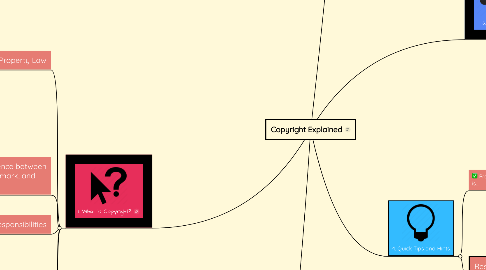
1. 1. What is Copyright?
1.1. Intellectual Property Law
1.1.1. Copyright protects creative expression that has been reduced to tangible form http://www.benedict.com/
1.1.1.1. Anything that is created using your own talent or work is protected by Copyright Law from letting others:
1.1.1.1.1. *Make copies
1.1.1.1.2. *Distribute copies
1.1.1.1.3. *Perform your work publically
1.1.1.1.4. *Display your work publically
1.1.1.1.5. *Make derivatives of your work
1.1.1.1.6. Examples: a book, piece of recorded music, computer program, screenplay, painting, photograph, or motion picture.
1.1.1.2. What is not protected under Copyright? http://www.copyrightkids.org/
1.1.1.2.1. Ideas, procedures, methods, systems, processes, concepts, principles, discoveries, or devices
1.1.1.2.2. Titles, names, short phrases, and slogans; mere listings of ingredients or contents
1.1.1.2.3. Works that are not fixed in a tangible form of expression, such as an improvised speech or performance that is not written down or otherwise recorded.
1.1.1.2.4. Works consisting entirely of information that is commonly available and contains no originality
1.1.1.2.5. Works by the US government
1.2. Is there a difference between copyright, trademark, and patent?
1.2.1. Yes
1.2.1.1. Trademark
1.2.1.2. Patent
1.3. Student Responsibilities
1.3.1. Abide by "Fair Use" Standards
1.3.2. Obtain Assignment of Rights
1.3.3. Understand the Basic Premises of Copyright Law
1.4. Teacher Responsibilities
1.4.1. TEACH Act
1.4.1.1. What is it?
1.4.1.1.1. "The TEACH Act facilitates and enables the performance and display of copyrighted materials for distance education by accredited, non-profit educational institutions (and some government entities) that meet the TEACH Act’s qualifying requirements."
1.4.1.2. Purpose?
1.4.1.2.1. "Its primary purpose is to balance the needs of distance learners and educators with the rights of copyright holders. The TEACH Act applies to distance education that includes the participation of any enrolled student, on or off campus."
1.4.2. Abide by "Fair Use" Standards
1.4.3. Obtain Assignment of Rights
1.4.4. Understand the Basic Premises of Copyright Law
1.5. How Do I know if I Have Copyright Ownership?
1.5.1. If you are the creator of a work that is fixed, original and expresses minimal creativity then you own the copyright.
2. 2. Copyright Basics
2.1. What Can Be Copyrighted?
2.1.1. Fixation
2.1.1.1. Example: Written on piece of paper
2.1.2. Originality
2.1.2.1. Example: Letter to a friend
2.1.3. Minimal Creativity
2.2. 1976 Copyright Act Section 106
2.2.1. Gives the owner of the work exclusive rights to. . .
2.2.1.1. Reproduction
2.2.1.2. Adaptation
2.2.1.3. Distribution to the public by sale or other transfer of ownership, or by rental, lease, or lending
2.2.1.4. Public Performance
2.2.1.5. Public Display
2.3. How long does Copyright last?
2.3.1. The duration of copyright protection for a work depends on several factors.
2.3.1.1. Date of Creation
2.3.1.1.1. 1977-Present
2.3.1.1.2. 1923-1976
2.3.1.1.3. Pre-1923
2.3.1.2. Registered or Published Work
2.3.1.3. Author is anonymous or under a pseudonym
2.3.1.4. Work for Hire
2.3.1.5. Jointly Created
2.4. Does work have to explicitly show a copyright symbol or notice to be considered legitimate?
2.4.1. No
2.5. What is Work for Hire?
2.5.1. A work prepared by an employee under the scope of employment
2.5.2. A work that is specifically commissioned.
2.5.3. The employer, not the employee, is the copyright owner.
3. 5. REVIEW
3.1. Gather in small groups of 3-4 to discuss and answer the following questions!
3.1.1. Please write down answers with all your names on a single piece of paper to turn in to the teacher.
3.1.1.1. Question 1
3.1.1.1.1. Summarize un 2-3 sentences what is Copyright law and the implications of the law.
3.1.1.2. Question 2
3.1.1.2.1. How long does Copyright last?
3.1.1.2.2. What is a "Work for Hire"?
3.1.1.2.3. What do Copyright owners hold the exclusive rights to?
3.1.1.3. Question 3
3.1.1.3.1. List and Describe the four Fair Use factors.
3.1.1.4. Question 4
3.1.1.4.1. Danny decides that he is going to save money and not buy a textbook, so instead he takes his friend's textbook and spends hours and tons of paper copying and printing the pages of his friend's textbook. Since his friend bought the textbook and Danny plans to use it for educational purposes, he thinks it is okay to do and does not breach Copyright law. Is he correct? Explain.
3.1.1.5. Question 5
3.1.1.5.1. Explore three different resources and summarizes what they explain about Copyright.
4. 3. Fair Use
4.1. Four Factors
4.1.1. Purpose and Character of Use
4.1.1.1. Nonprofit Educational
4.1.1.2. Commercial
4.1.1.3. Transformative
4.1.2. Nature of Work
4.1.2.1. Non-Fiction
4.1.2.2. Previously Published
4.1.2.3. Fiction
4.1.2.4. Unpublished
4.1.2.5. Been Created for Educational Purpose (i.e. Textbooks)
4.1.3. Amount and Substance of Part of Work being Used
4.1.3.1. Heart of the Work
4.1.4. Effect of Use on the Market
4.1.4.1. Deprives Author's Income
4.1.4.2. Undermines New or Potential Market
4.2. Is the Use Spontaneous?
4.2.1. No
4.2.2. Yes
4.3. What Counts as Fair Use?
4.4. When Should You Seek Permission?
4.4.1. Intend for Commercial Purposes
4.4.2. Intend to Use Work Enirely
4.4.3. Intend to Use Work Repeatedly
5. 4. Quick Tips and Hints
5.1. Product CAN be used if Copyright is...
5.1.1. Expired.
5.1.2. Public Domain.
5.1.3. Permitted by author.
5.1.4. *You are an educator and under the Fair Use Act.
5.2. Resources
5.2.1. Welcome To The FACE Kids Site
5.2.2. Fair Use Checklist
5.2.3. UMUC Library
5.2.4. Copyright Basics
5.2.5. Copyright Notice
5.2.6. Copyright.gov

